 (Download a higher resolution picture
by clicking on any picture below.)
(Download a higher resolution picture
by clicking on any picture below.)
NASA's Boeing NB-52B Stratofortress Mothership on Display |
 (Download a higher resolution picture
by clicking on any picture below.)
(Download a higher resolution picture
by clicking on any picture below.)
The Boeing NB-52B Stratofortress mothership 52-0008 has been placed on display outside the north gate of Edwards Air Force Base, off Highway 58 between Mojave and Boron. It is accessible to the public. There is a turn around just before the security post and a parking area adjacent to the NB-52B.
See the NB-52B in Google Earth.
 The yellow NASA tail band was added to the vertical stabilizer when the NB-52B was loaned from the Air Force to NASA in 1976. The black walkway stripes appear only on the left side of the stabilizer because the tail can be folded over to the right. The pictures of the left side of the Stratofotress mothership were taken on the afternoon of March 14, 2008.
The yellow NASA tail band was added to the vertical stabilizer when the NB-52B was loaned from the Air Force to NASA in 1976. The black walkway stripes appear only on the left side of the stabilizer because the tail can be folded over to the right. The pictures of the left side of the Stratofotress mothership were taken on the afternoon of March 14, 2008.
You can buy framed prints and greeting cardds of this photograph.
 The Air Force Systems Command badge on the left side of the nose has faded badly.
The Air Force Systems Command badge on the left side of the nose has faded badly.
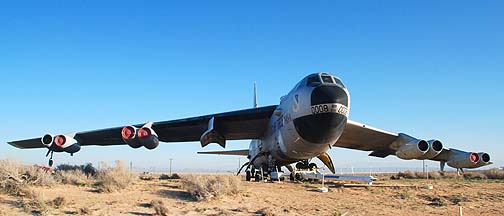 The last four digits of the NB-52B's Air Force serial number, 0008, appear on each side of the nose.
The last four digits of the NB-52B's Air Force serial number, 0008, appear on each side of the nose.
 The right side of the NB-52B is covered in badges, text, and mission marks. The pictures of the right side of the Stratofotress mothership were taken on the morning of February 20, 2010.
The right side of the NB-52B is covered in badges, text, and mission marks. The pictures of the right side of the Stratofotress mothership were taken on the morning of February 20, 2010.
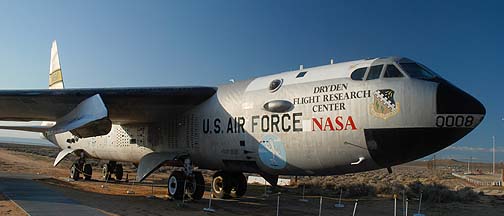 The most recent change to the appearance of the NB-52B is the text reading DRYDEN FLIGHT RESEARCH CENTER and NASA. It was added in the Summer of 2004, so it appeared on the NB-52B on only one launch mission. Aside from the addition of the mission marks, the markings of the NB-52B hadn't changed since 1976.
The most recent change to the appearance of the NB-52B is the text reading DRYDEN FLIGHT RESEARCH CENTER and NASA. It was added in the Summer of 2004, so it appeared on the NB-52B on only one launch mission. Aside from the addition of the mission marks, the markings of the NB-52B hadn't changed since 1976.
You can buy framed prints and greeting cardds of this photograph.
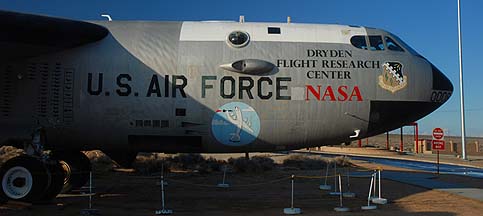 The NB-52B wears the old version of the Air Force Flight Test Center badge, which reads "AD INEXPLORATA" (Latin for "Toward the unknown") rather than saying "AIR FORCE FLIGHT TEST CENTER". The nose art depicting a B-52 throwing an X-15 was first painted on the NB-52B by C. A. May in September 1964.
The NB-52B wears the old version of the Air Force Flight Test Center badge, which reads "AD INEXPLORATA" (Latin for "Toward the unknown") rather than saying "AIR FORCE FLIGHT TEST CENTER". The nose art depicting a B-52 throwing an X-15 was first painted on the NB-52B by C. A. May in September 1964.
Panorama size: 994 megapixels (36905 x 26961 pixels)
Input images: 342 (18 columns by 19 rows)
Field of view: 188.9 degrees wide by 138.0 degrees high (top=88.5, bottom=-49.5)
You can buy framed prints of this photograph.
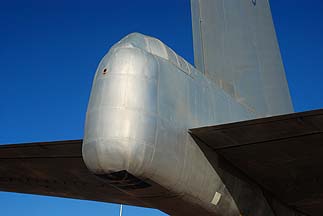 The tail turret was removed and faired over.
The tail turret was removed and faired over.
 The outboard side of the X-15 pylon has been painted white. It has text reading HYPER-X and X-43. The old NASA meatball also graces the pylon.
The outboard side of the X-15 pylon has been painted white. It has text reading HYPER-X and X-43. The old NASA meatball also graces the pylon.
 The inboard side of the pylon has always been painted matte black.
The inboard side of the pylon has always been painted matte black.
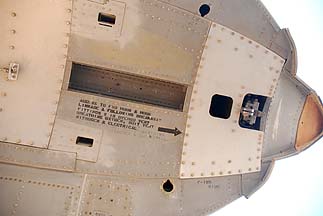 The forward support hook at the front of the launch pylon. The stencil reads:
The forward support hook at the front of the launch pylon. The stencil reads:
ACCESS TO FWD HOOK & HOOK
LINKAGE AND FOLLOWING BREAKAWAY
FITTINGS X 15 OVERBD VENT
BREATHING OXYGEN, SUIT VENT
NITROGEN AND ELECTRICAL
 Moving aft along the inboard pylon: Access panels F-135 and F-133. The stencil reads:
Moving aft along the inboard pylon: Access panels F-135 and F-133. The stencil reads:
ACCESS TO PRE-LAUNCH
LOX TEST VENT SYSTEM
WARNING-PRE LAUNCH LOX
FILLER-KEEP CLEAR
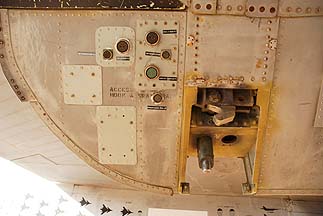 Inboard aft hook. An old, faded stencil reads:
Inboard aft hook. An old, faded stencil reads:
ACCESS TO AFT
HOOK & SWAY BRACE
Several electrical connectors were added after the conclusion of the X-15 program. The labels read:
INSTRUMENTATION TC.
HXLVJ2 M/W P12
HXLVJ1 M/W P11
INSTRUMENTATION
HXRV A/P J1 M/W A/P P1
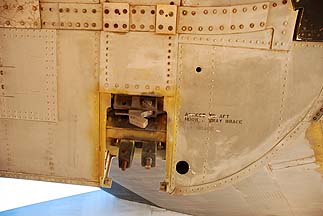 Outboard aft hook. The stencil reads:
Outboard aft hook. The stencil reads:
ACCESS TO AFT
HOOK & SWAY BRACE
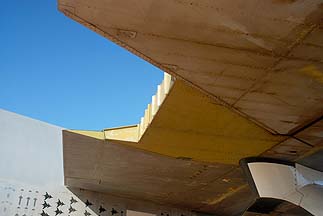 The slot that was cut into the right wing of the NB-52B for the tail of the X-15 is partly filled with an insert that allowed clearance for the tail of the X-43A Hyper-X satck. During the supersonic cruise fuel additive tests in 1994-1995, a close-out structure completely filled the slot.
The slot that was cut into the right wing of the NB-52B for the tail of the X-15 is partly filled with an insert that allowed clearance for the tail of the X-43A Hyper-X satck. During the supersonic cruise fuel additive tests in 1994-1995, a close-out structure completely filled the slot.
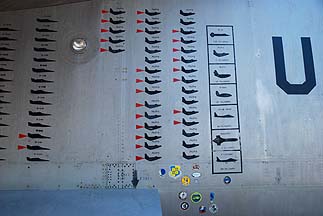 Many of the missions flown by the NB-52B are represented by the symbols in the rectangles at the right: 140 X-15 flights, 17 M2-F2 flights, 37 HL-10 flights, 27 X-24A flights, 41 F-15 RPRV flights, 9 SRB/DTV flights, and 29 F-15/SRV flights.
Many of the missions flown by the NB-52B are represented by the symbols in the rectangles at the right: 140 X-15 flights, 17 M2-F2 flights, 37 HL-10 flights, 27 X-24A flights, 41 F-15 RPRV flights, 9 SRB/DTV flights, and 29 F-15/SRV flights.
Thirty-five M2-F3 marks appear to the left of the mission tallys. Twenty-five marks include a red triangle indicating a rocket-powered flight. The NB-52B first carried the M2-F3 on May 22, 1970. The last M2-F3 launch occurred on December 20, 1972.
The NB-52B has accumulated a collection of stickers below the M2-F3 marks. These include badges from the Experimental Aircraft Association, Tinker Air Force Base, Phoenix Air (illegible) Copperheads, 337th Test Squadron, MAINEiacs, 2953 CLSS, 931st Air Refueling Group at McConnell Air Force Base, Boeing Fire Department, and the 23rd Bomb Squadron. The blue sticker at the lower right is no longer readable, but it is the badge of the 562nd Tactical Fighter Training Squadron, which was based at the former George Air Force Base. Three stickers have been applied since the retirement ceremony for the NB-52B was held on December 17, 2004.
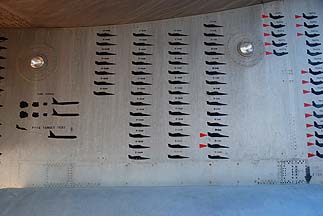 Forty-seven X-24B marks appear to the left of the M2-F3 marks. Although only two X-24B marks include the red triangle indicating a rocket-powered flight, the X-24B flew twelve powered flights. The NB-52B first carried the X-24B on July 19, 1973. The last X-24B launch occurred on November 26, 1975. Floodlights can be seen on either side of the X-24B marks.
Forty-seven X-24B marks appear to the left of the M2-F3 marks. Although only two X-24B marks include the red triangle indicating a rocket-powered flight, the X-24B flew twelve powered flights. The NB-52B first carried the X-24B on July 19, 1973. The last X-24B launch occurred on November 26, 1975. Floodlights can be seen on either side of the X-24B marks.
 Two B-52 silhouettes at center represent Wake Vortex tests and one represents an F-16 Target Test. The NB-52B flew past a tower equipped with meteorological instruments near Idaho Falls, Idaho in October and December 1977. I have not determined the date of the F-16 Target Test. Ten marks represent flights by the F-15 Spin Research Vehicles, although the three vehicles were launched twenty-six times. The first F-15 SRV flight was launched on November 29, 1977 and the last was launched on July 15, 1981.
Two B-52 silhouettes at center represent Wake Vortex tests and one represents an F-16 Target Test. The NB-52B flew past a tower equipped with meteorological instruments near Idaho Falls, Idaho in October and December 1977. I have not determined the date of the F-16 Target Test. Ten marks represent flights by the F-15 Spin Research Vehicles, although the three vehicles were launched twenty-six times. The first F-15 SRV flight was launched on November 29, 1977 and the last was launched on July 15, 1981.
 Thirteen marks represent the Shuttle Reusable Booster/Drop Test Vehicle (SRB/DTV). Two horizontal silhouettes at upper right indicate captive carry flights flown on June 10, 1977. Below those silhouettes are two more representing the first series of six drops of the SRB/DTV, which began on June 15, 1977 and ended on September 12, 1978.
Thirteen marks represent the Shuttle Reusable Booster/Drop Test Vehicle (SRB/DTV). Two horizontal silhouettes at upper right indicate captive carry flights flown on June 10, 1977. Below those silhouettes are two more representing the first series of six drops of the SRB/DTV, which began on June 15, 1977 and ended on September 12, 1978.
The nine SRB/DTV marks to the left represent a second series of drops of the SRB/DTV. Three large stabilizing fins were added to the SRB/DTV. The SRB/DTV silhouettes for the second series of drops show the fins. The first drop was scheduled for February 23, 1983, but the rear hooks on the X-15 pylon failed as the NB-52B was taxiing. The horizontal silhouette with the hook at the front represents that incident. The first of eight drops in the second series was flown on September 16, 1983. The last was flown on March 20, 1985. The parachutes separated from the SRB/DTV on one flight, which is represented by a silhouette with a ground line and Joshua Trees on each side.
The B-52 silhouette at the bottom represents the day that the hooks failed on the X-15 pylon. Very small letters underneath the silhouette read "T.F.H.B." (The F***ing Hook Broke).
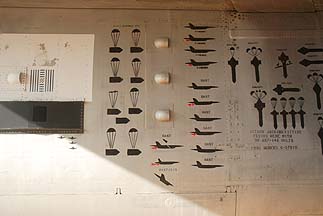 Thirteen silhouettes at right represent flights of modified Ryan BQM-34 Firebee II drones in support of the Drones for Aeroelastic Structures Testing (DAST) program.
Thirteen silhouettes at right represent flights of modified Ryan BQM-34 Firebee II drones in support of the Drones for Aeroelastic Structures Testing (DAST) program.
The two marks at the top represent flights of a nearly stock Firebee II. Three captive-carry flights were flown in November and December 1975, and July 1977. The Firebee II was launched from the NB-52B once on July 28, 1977.
The next two marks represent the Firebee II equipped with an instrumented wing called "Blue Streak". The NB-52B made one captive-carry flight and one launch of the Blue Streak in March 1979.
The six lower marks and two to the left represent the Drones for Aeroelastic Structures Testing. The first DAST drone was carried on the NB-52B for the first time on September 14, 1979. It was launched three times, the first time on October 2, 1979 and the last time on June 12, 1980. On the last flight, its right wing failed and the drone crashed in the desert. That flight is represented by the mark directly below the three bomb bay vents.
The second DAST drone was carried on its first captive carry flight on October 29, 1982. It was launched from the NB-52B once on November 3, 1982. DAST II made two more captive-carry flights in early 1983, but all subsequent launches were made from a Navy Lockheed DC-130A Hercules. The bottom silhouette in the left column is said to represent a launch of the DAST II drone from the DC-130A.
Nine marks to the left of the bomb bay vents represent drops of the F-111 Parachute Test Vehicle (PTV) from the bomb bay of the NB-52B. Increases in the weight of the F-111 escape module resulted in a requirement for a new parachute recovery system. The first series of eight PTV drops ran from February 1979 to August 1979.
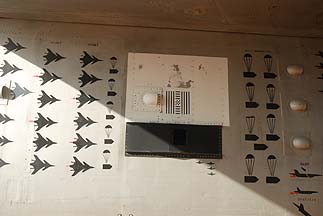 The black rectangle appears to be a camera housing. There is a photo resolution target in the white rectangle above the camera housing. It looks like there once was a mirror on the X-15 pylon that reflected an image of the photo resolution target to the camera. I do not know the reason.
The black rectangle appears to be a camera housing. There is a photo resolution target in the white rectangle above the camera housing. It looks like there once was a mirror on the X-15 pylon that reflected an image of the photo resolution target to the camera. I do not know the reason.
I have not identified the four bat-like marks below the camera housing.
Five more F-111 PTV marks appear to the left of the camera housing and photo target. A second test series of eleven PTV drops was conducted in 1982. The first drop of the second test series was flown on March 3, 1982. The last drop of the second PTV test series was flown in November 1982.
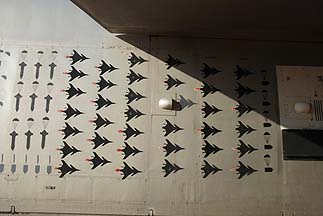 Thirty-eight silhouettes represent the two Highly Maneuverable Aircraft Technology (HiMAT) drones. Twenty-seven silhouettes have red flames indicating a powered flight. The NB-52B launched the first HiMAT drone fourteen times and the second HiMAT drone 12 times. The first captive-carry HiMAT flight was flown on July 11, 1979. The first HiMAT launch occurred on July 27, 1979 and the last occurred on January 12, 1983.
Thirty-eight silhouettes represent the two Highly Maneuverable Aircraft Technology (HiMAT) drones. Twenty-seven silhouettes have red flames indicating a powered flight. The NB-52B launched the first HiMAT drone fourteen times and the second HiMAT drone 12 times. The first captive-carry HiMAT flight was flown on July 11, 1979. The first HiMAT launch occurred on July 27, 1979 and the last occurred on January 12, 1983.
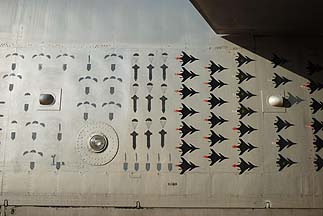 Nine marks represent a third series of drops of the SRB/DTV. I do not know the dates of those tests.
Nine marks represent a third series of drops of the SRB/DTV. I do not know the dates of those tests.
 Twenty-three more F-111 PTV drop test marks appear below and to the left of the SRB/DTV marks. A third series of twelve PTV drops was conducted from July 7, 1987 to November 9, 1988. A fourth series of eleven PTV drops began in May 1989. The last drop of the fourth test series was flown in February 1990. Seven of the marks appear to show reefed parachutes. One mark represents a parachute failure that resulted in the PTV impacting in the desert at the China Lake Naval Air Weapons Station.
Twenty-three more F-111 PTV drop test marks appear below and to the left of the SRB/DTV marks. A third series of twelve PTV drops was conducted from July 7, 1987 to November 9, 1988. A fourth series of eleven PTV drops began in May 1989. The last drop of the fourth test series was flown in February 1990. Seven of the marks appear to show reefed parachutes. One mark represents a parachute failure that resulted in the PTV impacting in the desert at the China Lake Naval Air Weapons Station.
Nine Orbital Sciences Pegasus sihouettes represent three captive carry flights and six launches. The NB-52B was the first airplane to launch a satellite into orbit on April 5, 1990. The NB-52B made its last Pegasus launch on August 3, 1994.
The original mission marks for the Pegasus were silhouettes of a winged horse. In June 2001, those marks were removed and replaced with silhouettes of the rocket. Other marks were removed and replaced at that time. Scuff marks can be seen where the old marks were removed.
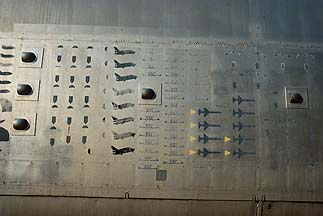 Thirty four marks represent flights that the NB-52B made with a pair of J85 jet engines mounted on a pallet in the bomb bay to test fuel additives for the reduction of emissions of pullutants during supersonic cruise flight. The fuel additive tests were conducted in 1994 and 1995. The X-15 pylon was removed and a close-out structure was installed in the notch in the trailing edge of the wing for these tests.
Thirty four marks represent flights that the NB-52B made with a pair of J85 jet engines mounted on a pallet in the bomb bay to test fuel additives for the reduction of emissions of pullutants during supersonic cruise flight. The fuel additive tests were conducted in 1994 and 1995. The X-15 pylon was removed and a close-out structure was installed in the notch in the trailing edge of the wing for these tests.
Eight space shuttle silhouettes represent tests of the drag chute used to decelerate the orbiters when they land. These tests were high-speed taxi runs at speeds up to 192 knots. Four tests were conducted on Rogers Dry Lake in July and August 1990. Four tests were conducted on Runway 22 in Septebmer and October 1990. The bottom silhouette represents a test in which the drag chute separated from the NB-52B.
Fifteen marks represent more tests of the F-111 PTV. A new 85-foot diameter ring sail parachute system was developed for the F-111 crew module. A fifth series of four drops of the PTV were flown to test the new parachute in February and March 1991. A sixth series of ten drops was conducted from June 1991 to November 1991. A seventh series of five drops began in March 1992.
Five bomb bay vents can be seen in this picture. They open to the rear.
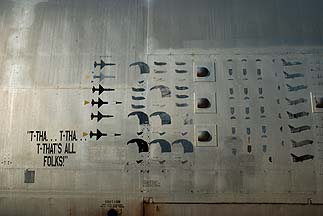 Twenty silhouettes represent twelve captive-carry flights and eight drops of the two X-38 Crew Return Vehicles. The NB-52B first carried the X-38 V-131 on August 2, 1997 and first launched it on March 12, 1998. The NB-52B first launched the X-38 V-132 on March 5, 1999. X-38 V-131 was modified and returned to flight as X-38 V-131R on November 2, 2000. The NB-52B last dropped X-38 V-131R on December 13, 2001.
Twenty silhouettes represent twelve captive-carry flights and eight drops of the two X-38 Crew Return Vehicles. The NB-52B first carried the X-38 V-131 on August 2, 1997 and first launched it on March 12, 1998. The NB-52B first launched the X-38 V-132 on March 5, 1999. X-38 V-131 was modified and returned to flight as X-38 V-131R on November 2, 2000. The NB-52B last dropped X-38 V-131R on December 13, 2001.
Six silhouettes represent three captive-carry flights and three launches of the X-43A Hyper-X. The first captive-carry flight was flown on April 28, 2001 and the first Hyper-X stack was launched on June 2, 2001. The silhouette for that flight shows the stabilizers breaking away from the modified Pegasus booster. Each of the successful launches of the X-43A was preceded by a captive-carry flight. The final flight of the NB-52B launched the third Hyper-X stack on November 16, 2004.
"T-THA...T-THA...T-THAT'S ALL FOLKS!" was added following the last flight of the NB-52B.
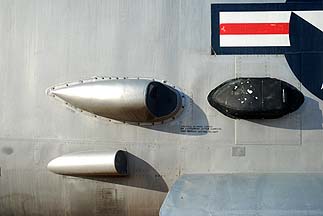 A video camera fairing, a movie camera housing and a floodlight were installed just above the right rear main landing gear door.
A video camera fairing, a movie camera housing and a floodlight were installed just above the right rear main landing gear door.
 Right side view as of November 2004.
Right side view as of November 2004.
 Right side view of fuselage as of November 2004.
Right side view of fuselage as of November 2004.
 Right side view of fuselage as it appeared during the launch of the second X-43A Hyper-X stack in March 2004. Aside from the addition of mission marks, it had not changed appreciably since 1976.
Right side view of fuselage as it appeared during the launch of the second X-43A Hyper-X stack in March 2004. Aside from the addition of mission marks, it had not changed appreciably since 1976.
 Right side view of fuselage showing modifications.
Right side view of fuselage showing modifications.
 Left side view of fuselage as of November 2004. It has not changed appreciably since 1976.
Left side view of fuselage as of November 2004. It has not changed appreciably since 1976.
| NASA Mission Tally | Missions | Launches |
| North American X-15 | 161 | 106 |
| Northrop M2-F2 | 13 | 13 |
| Northrop M2-F3 | 34 | 27 |
| Northrop HL-10 | 37 | 26 |
| Martin-Marietta X-24A | 31 | 25 |
| Martin-Marietta X-24B | 49 | 36 |
| F-15 Remotely Piloted Research Vehicle (RPRV) | 41 | 27 |
| F-15 Spin Research Vehicle (SRV) | 32 | 26 |
| Shuttle Reusable Booster/Drop Test Vehicle (SRB/DTV) | 22 | 14 |
| Drones for Aeroelastic Structures Testing (DAST) | 13 | 5 |
| F-111 Parachute Test Vehicle (PTV) | 57 | 57 |
| Highly Maneuverable Aircraft Technology (HiMAT) | 40 | 26 |
| Orbital Sciences Pegasus | 13 | 6 |
| X-38 Crew Return Vehicle | 21 | 8 |
| X-43A Hyper-X | 6 | 3 |
 Boeing NB-52B
Stratofortress Mothership.
Boeing NB-52B
Stratofortress Mothership.
eBook edition of Balls Eight: History of the Boeing NB-52B Stratofortress Mothership |
||
|
My book Balls Eight: History of the Boeing NB-52B Stratofortress Mothership is now available as an eBook for just $10.99, a considerably reduced price compared to the print edition. It has been asserted that the Boeing NB-52B Stratofortress, carrying Air Force serial 52-0008, can lay claim to being the airplane that has seen and participated in more history than any other single airplane. For forty-five years, the NB-52B was a fixture at Edwards Air Force Base. While the NB-52B is most famous for launching the three North American X-15 rocket planes, it continued to serve in the role of launch platform for a multitude of programs until its final mission, launching the Mach-10 X-43A Hyper-X, on November 16, 2004. It was the oldest flying B-52 by nearly ten years. The eBook edition is profusely illustrated with vintage photographs and diagrams and has more pictures than the print edition. It can be dowloaded directly from Lulu.com. It will soon be available from Apple iBookstore, Amazon, Barnes & Noble, and Kobo. | ||
|
Balls Eight: History of the Boeing NB-52B Stratofortress Mothership |
||
It has been asserted that the Boeing NB-52B Stratofortress, carrying Air Force serial 52-0008, can lay claim to being the airplane that has seen and participated in more history than any other single airplane. For forty-five years, the NB-52B was a fixture at Edwards Air Force Base. While the NB-52B is most famous for launching the three North American X-15 rocket planes, it continued to serve in the role of launch platform for a multitude of programs until its final mission on November 16, 2004. It was the oldest flying B-52 by nearly ten years.The NB-52B launched the three X-15 hypersonic rocket planes.
It launched the Northrop HL-10, Northrop M2-F2/F3, Martin Marietta X-24A and Martin Marietta X-24B lifting bodies.
It simulated the steep, power off approach to landing used by the Space Shuttles.
It assisted in the collection of data about wake turbulence from large aircraft.
It served as an air-to-air gunnery target.
It launched 3/8-scale F-15 Remotely Piloted Research Vehicles (RPRV) and Spin Research Vehicles (SRV).
It launched a Ryan Firebee II drone and the Ryan Firebee based Drones for Aeroelastic Structures Testing (DAST).
It launched the Highly Maneuverable Aircraft Technology (HiMAT) RPRVs.
It dropped the 48,000-pound Space Shuttle Reusable Booster Drop Test Vehicle (SRB/DTV).
It released a simulated F-111 crew module from its bomb bay to evaluate new parachute recovery systems.
It was the first airplane to launch a satellite into orbit on the Orbital Sciences Pegasus booster.
It tested the drag chute used to decelerate space shuttle orbiters.
It tested pollution reducing fuel additives with a pair of jet engines mounted under its bomb bay.
It launched the X-38 Space Station Crew Return Vehicles.
It launched the X-43A Hyper-X Supersonic Combustion Ramjets.
The book is 200 pages long. It contains 246 color photographs, 89 black and white photographs, and 2 other illustrations.
You can preview the first several pages of the book.
Books are printed on demand by Lulu.com. When you order one, it is placed in your Lulu.com shopping cart. Lulu.com prints, packages, and ships the book direct to you.

Put a copy of the softcover edition of Balls Eight: History of the Boeing NB-52B Stratofortress Mothership in your Lulu.com shopping cart for $74.95.

Put a copy of the hardcover edition of Balls Eight: History of the Boeing NB-52B Stratofortress Mothership in your Lulu.com shopping cart for $79.95.
Revell has re-released Monogram's 1/72-scale Boeing NB-52B Stratofortress with X-15A-2 kit. You need this book to help you establish the appropriate paint scheme for any particular NB-52B mission that you want to model.
The book is 96 pages long.
You can preview the first several pages of the book.
Books are printed on demand by Lulu.com. When you order one, it is placed in your Lulu.com shopping cart. Lulu.com prints, packages, and ships the book direct to you.
 Put a copy of the softcover edition of Painting Guide for the Boeing Stratofortress Motherships in your Lulu.com shopping cart for $44.95.
Put a copy of the softcover edition of Painting Guide for the Boeing Stratofortress Motherships in your Lulu.com shopping cart for $44.95.
You can buy a 2020 calendar featuring photographs of the Boeing NB-52B Stratofortress Mothership that launched the X-15s in the 1960s and continued launching research vehicles until 2004.
It has been asserted that the Boeing NB-52B Stratofortress, carrying Air Force serial 52-0008, can lay claim to being the airplane that has seen and participated in more history than any other single airplane. This calendar features a dozen pictures of the NB-52B carrying some of the research vehicles that it launched over the years. Photo sources: Air Force, NASA, Richard Lockett, Brian Lockett:
North American X-15-1, 1960
North American X-15-3, 1963
North American X-15A-2, 1967
Northrop HL-10, 1969
Martin-Mariettta X-24A, 1970
Northrop M2-F3, 1972
Martin-Mariettta X-24B, 1973
Orbital Sciences Pegasus, 1989
Supersonic Supercruise, 1995
X-38 V-131R, 2000
X-43A Hyper-X, 2004
 Put a copy of the Balls Eight: Boeing NB-52B Stratofortress Mothership: 2020 calendar in your Lulu.com shopping cart for $14.95.
Put a copy of the Balls Eight: Boeing NB-52B Stratofortress Mothership: 2020 calendar in your Lulu.com shopping cart for $14.95.
 Books about
Lifting Bodies, Edwards Air Force Base, and the X-43 available
from
Books about
Lifting Bodies, Edwards Air Force Base, and the X-43 available
from 
 The X-Planes: X-1 to X-45: 3rd Edition
by Jay Miller
The X-Planes: X-1 to X-45: 3rd Edition
by Jay Miller
 Flying Without Wings : Nasa Lifting
Bodies and the Birth of the Space Shuttle by Milton O. Thompson
Flying Without Wings : Nasa Lifting
Bodies and the Birth of the Space Shuttle by Milton O. Thompson
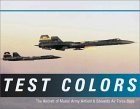 Test Colors: The Aircraft of Muroc Army Airfield
and Edwards Air Force Base by Rene Francillon
Test Colors: The Aircraft of Muroc Army Airfield
and Edwards Air Force Base by Rene Francillon
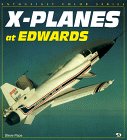 X-Planes at Edwards (Enthusiast Color
Series) by
Steve Pace
X-Planes at Edwards (Enthusiast Color
Series) by
Steve Pace
 Edwards Air Force Base : Open House at the USAF
Flight Test Center 1957-1966 : A Photo Chronicle of
Aircraft Displayed (Schiffer Military History) by Robert D. Archer
Edwards Air Force Base : Open House at the USAF
Flight Test Center 1957-1966 : A Photo Chronicle of
Aircraft Displayed (Schiffer Military History) by Robert D. Archer
 Angle of Attack : Harrison Storms and the Race to
the Moon by Mike Gray. The biography of Harrison Storms, who
was instrumental in the development and operation of the X-15.
Angle of Attack : Harrison Storms and the Race to
the Moon by Mike Gray. The biography of Harrison Storms, who
was instrumental in the development and operation of the X-15.
 At the Edge of Space : The X-15 Flight Program
by Milton O. Thompson. The story of test flying the X-15 from the
point of view of the pilot.
At the Edge of Space : The X-15 Flight Program
by Milton O. Thompson. The story of test flying the X-15 from the
point of view of the pilot.
 Send a message to Brian.
Send a message to Brian.